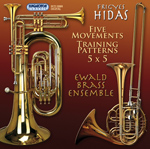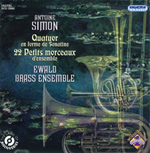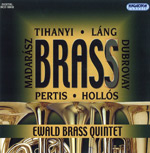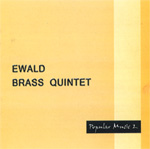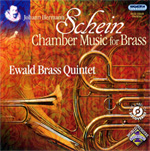Tenth CD: Frigyes Hidas
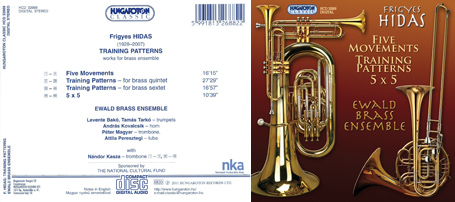
Description
The rich oeuvre of Frigyes Hidas (1928–2007), composer and conductor, contributed largely to the wealth of contemporary Hungarian brass repertory. Not only the considerable number of his wind concertos and his splendid, inventive chamber music output for winds are meant. Hidas was the past-master of wind orchestra repertory whose works are played with zeal all over the world by professional and amateur ensembles alike. At the same time he was the first composer to entrust the orchestral parts of a Requiem employing solo singers and choir to the instruments of the wind ensemble.
Frigyes Hidas studied at the Budapest Academy of Music with János Viski. From 1950 onwards he occupied the post of conductor and music director, respectively, at several Budapest theatres: He worked for the Youth Theatre, the National Theatre, the Municipal Operetta Theatre and was even choirmaster at the St. Stephen’s Basilica. He wrote incidental music to several stage works, television and radio plays as well as film music. The new organ of the Béla Bartók National Concert Hall in Budapest was inaugurated with the première of Frigyes Hidas’s Organ Concerto in company of other works. The composer received the Erkel-Prize twice, in 1959 and 1980, was awarded the title Merited Artist in 1987 and the Bartók-Pásztory-Prize for his achievements in 1993.
On the present recording the Ewald Brass Ensemble’s programme selected from the master’s brass chamber music can be heard.
The work Five Movements (1973) for brass sextet (three trumpets, two trombones, and tuba) evokes the tone and structure of the world of Renaissance-early Baroque-classical brass music (tower music, intradas, partitas, divertimentos). The introductory Signal begins with a four-bar introduction consisting of two upwards striving dotted fourth motives and of a stepping conclusion also built on fourths; this musical material as well as the virtuoso staccato motif with tone repetition emerging in the course of the elaboration anticipates the entire musical material of the piece. The main part of the tensely chromatic first Scherzo (4/4) rests on the repetition of dactyl motives in tempestuous tempo with the break of the short, calmer trio. The Interludium in moderate tempo and meditative tone is the most extensive and emphatic central movement of the piece. In the reprise its delienated, agile main theme is heard – as a peculiarity of its freely treated sonata-form – in augmented form, in the company of an agitated staccato accompaniment again. The second Scherzo is a full-blooded tarantella in 12/8 time while the last movement is Choral, an impressive brass chorus re-interpreting in contemporary manner the quiet four-part vocal chorale settings.
The composer wrote two sets of short pieces with the strange title Training Patterns (1983) bearing distant associations. Their aim was to provide young instrumentalists grown weary of studies with the opportunity to start a common play as a kind of relaxation. As the composer worded it: I composed and compiled my “Training Patterns” for young brass players. My admitted intention was to help them relax from time to time from the so indispensable and so boring medium of solo studies and get at the same time involved with a kind of playful seriousness (and on beginners’ level already!) in the the exciting world of chamber music making, of instrumental co-operation.
Naturally, the individual pieces of the set comprise educational objectives as well (practising the solution of rhythmic, attack problems etc.).
The laconic brevity of the pieces is meant to prevent the possible weakening of attention.
With easily surveyable forms, clear structure and last but not least with ideas “provoking” the young players’ imagination this set of pieces wishes to show the way in the manner of “warming up training” towards the “great, decisive games” of professional common music making.
The emphasis is therefore on playing, on playfulness. We are faced with a whole range of witty musical ideas in which Hidas puts on display his whole knowledge of brass wind instruments. To what extent is it relaxation?
Well, occasionally the fun and play prove to be extremely demanding even if they are not intended for the music school or secondary school age group. The 24 pieces of the first set were composed for brass quintet (two trumpets, horn, trombone, tuba): each of the short movements aims at presenting a single musical motif, technical element in the manner of Baroque inventions; the pieces representing staccato-technique in varied disguise, the witty rhythmic plays, lilting cantilenas, sicilianos bringing calming down and the stormily rolled tone repetitions use one kind of setting, are built on one kind of musical character. The 16 pieces of the second set were written for brass sextet in similar build-up. The set is rounded off here with a chorale of fascinating mood.
Enikő Gyenge
English translation by Erzsébet Mészáros
Tracklist and listening samples
| 1-5 | Five Movements 16'15'' |
| 1 I. Signal. Moderato |
|
| 2 II. Scherzo 1. Allegro con brio |
|
| 3 III. Interludium. Moderato molto |
|
| 4 IV. Scherzo 2. Allegro vivace |
|
| 5 IV. Choral |
|
| 6-29 | Training Patterns 27'29'' |
| 30-45 | Training Patterns 16'57'' |
| 46-60 | 5 X 5 10'39'' |
Total time: 71'20''

